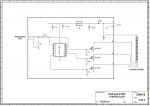johnmobley
New Member
I am wanting/trying to control some 12VDC LEDs via PWM using a PICAXE 14M2. What is the best method to do this. Working with PWM and LEDs is not new to me but trying to control them at higher voltages is new for me.
'loop RGB LED Control
'May 2012
'Picaxe 14M2
#picaxe 14m2
#No_Data
symbol counter = W2
symbol Green = W3
symbol Blue = W4
symbol loopcount = b0
symbol Redout = b.2
symbol Blueout = c.0
symbol Greenout = b.4
dirsb=%00011111
dirsc=%00000111
pwmout Redout,100,0
pwmout Blueout,100,255
pwmout Greenout,100,0
main:
gosub fade
'
goto main
fade:
for counter = 0 to 255
pwmduty Redout,counter
w5 = 255-counter
pwmduty Blueout,w5
pause 10
next counter
pause 400
for counter = 0 to 255
pwmduty Greenout,counter
w5 = 255-counter
pwmduty Redout,w5
pause 10
next counter
Pause 400
pwmduty Redout,0
pause 200
for counter = 0 to 255
pwmduty Blueout,counter
w5 = 255-counter
pwmduty Greenout,w5
pause 10
next counter
pause 400
for counter = 0 to 255
w5 = 255-counter
pwmduty Blueout,w5
pwmduty Redout,counter
pwmduty greenout,counter
pause 10
next counter
pause 400
for counter = 0 to 255
w5 = 255-counter
pwmduty Blueout,counter
pause 10
next counter
pause 400
' pause 50
'
'
'pwmout Redout,off
'pwmout Blueout,off
'pwmout Greenout,off
return
- 20mA is a lot for an led indicator, you might be happy with 10 or even 5. These could also be in series. The leds might be connected across the switch contacts but might be separately powered, worth considering the options.
- leds generally don't need 4 - 5 volts. Try a sample and see what they drop at the desired current. Constant current is a much better way of thinking about them. But a series string would work. Consider more than 12v if you need long strings, connected via a pwm-driven constant-current supply.
- Mosfets for pwm switching are necessary, even better 'coolfets' with lower on resistance. Most mosfets/coolfets need a driver chip to ensure a high enough gate switchon voltage (logic level ones may not). Picaxe fed from 5v, driver and mosfet from 12v (or higher).
- depending on layout, cable capacity may be an issue due to voltage drop at high current, and little voltage to spare.
My kitchen lights are all 12v led units driven in this way from a 12v (car battery) supply with push-button control and pwm for reduced level settings.
search for SPP20N60C3 from Infineon
